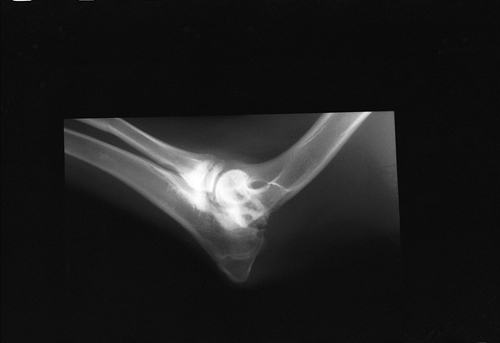Difference between revisions of "Small Animal Orthopaedics Q&A 18"
Jump to navigation
Jump to search
(Created page with "[[|centre|500px]] <br /> '''A lateral view radiograph of the left elbow of a five-month-old Irish Wolfhound with a left forelimb lameness of four weeks’ duration.''' <br /> ...") |
|||
| (2 intermediate revisions by 2 users not shown) | |||
| Line 1: | Line 1: | ||
| − | [[|centre|500px]] | + | {{Manson |
| + | |book = Small Animal Orthopaedics Q&A}} | ||
| + | |||
| + | [[File:SmAnOrth 18.jpg|centre|500px]] | ||
<br /> | <br /> | ||
| Line 13: | Line 16: | ||
There are early degenerative changes present in the elbow. | There are early degenerative changes present in the elbow. | ||
| − | |l1= | + | |l1=Elbow Dysplasia |
|q2=List three treatment options for this condition. | |q2=List three treatment options for this condition. | ||
|a2= | |a2= | ||
| Line 19: | Line 22: | ||
#Lag screw fixation of the united anconeal process. Although stabilization of the ununited anconeal process using lag screw fixation has been purported to be associated with numerous technical complications and to be of questionable value, a recent study reported radiographic union of the ununited anconeal process following lag screw stabilization in five of six elbows available for follow-up evaluation. Unfortunately, details regarding elbow and limb function were not included. | #Lag screw fixation of the united anconeal process. Although stabilization of the ununited anconeal process using lag screw fixation has been purported to be associated with numerous technical complications and to be of questionable value, a recent study reported radiographic union of the ununited anconeal process following lag screw stabilization in five of six elbows available for follow-up evaluation. Unfortunately, details regarding elbow and limb function were not included. | ||
#Proximal diaphyseal ulnar osteotomy. Elbow incongruity, specifically proximal subluxation of the radial head, exerts abnormal stress on the developing anconeal process indirectly via the humeral condyle which results in failure of the process to fuse with the ulna. In a recent study, 15 of 17 dogs unilaterally affected with ununited anconeal processes had proximal displacement of the radial head in the affected elbow. Proximal diaphyseal ulnar osteotomy is performed to restore congruency of the elbow, thereby relieving the abnormal load on the anconeal process. In the above study the anconeal process fused in 21 of 22 elbows treated in this manner and limb function was generally favorable. This procedure is probably most efficacious in young dogs. Whether restoration of congruency improves elbow function in association with process excision or lag screw fixation in older dogs has yet to be established. | #Proximal diaphyseal ulnar osteotomy. Elbow incongruity, specifically proximal subluxation of the radial head, exerts abnormal stress on the developing anconeal process indirectly via the humeral condyle which results in failure of the process to fuse with the ulna. In a recent study, 15 of 17 dogs unilaterally affected with ununited anconeal processes had proximal displacement of the radial head in the affected elbow. Proximal diaphyseal ulnar osteotomy is performed to restore congruency of the elbow, thereby relieving the abnormal load on the anconeal process. In the above study the anconeal process fused in 21 of 22 elbows treated in this manner and limb function was generally favorable. This procedure is probably most efficacious in young dogs. Whether restoration of congruency improves elbow function in association with process excision or lag screw fixation in older dogs has yet to be established. | ||
| − | |l2= | + | |l2=Elbow Dysplasia#Treatment |
</FlashCard> | </FlashCard> | ||
Latest revision as of 13:09, 26 October 2011
| This question was provided by Manson Publishing as part of the OVAL Project. See more Small Animal Orthopaedics Q&A. |
A lateral view radiograph of the left elbow of a five-month-old Irish Wolfhound with a left forelimb lameness of four weeks’ duration.
| Question | Answer | Article | |
| Describe the radiographic abnormalities. | The radial head is subluxated proximally and the anconeal process has failed to unite with the ulna. There are early degenerative changes present in the elbow. |
Link to Article | |
| List three treatment options for this condition. |
|
Link to Article | |
